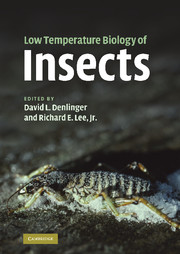Book contents
- Frontmatter
- Contents
- List of contributors
- Preface
- PART I PHYSIOLOGICAL AND MOLECULAR RESPONSES
- 1 A primer on insect cold-tolerance
- 2 Rapid cold-hardening: Ecological significance and underpinning mechanisms
- 3 Antifreeze and ice-nucleator proteins
- 4 Genomics, proteomics and metabolomics: Finding the other players in insect cold-tolerance
- 5 Cell structural modifications in insects at low temperatures
- 6 Oxygen: Stress and adaptation in cold-hardy insects
- 7 Interactions between cold, desiccation and environmental toxins
- PART II ECOLOGICAL AND EVOLUTIONARY RESPONSES
- PART III PRACTICAL APPLICATIONS
- Index
- References
6 - Oxygen: Stress and adaptation in cold-hardy insects
from PART I - PHYSIOLOGICAL AND MOLECULAR RESPONSES
Published online by Cambridge University Press: 04 May 2010
- Frontmatter
- Contents
- List of contributors
- Preface
- PART I PHYSIOLOGICAL AND MOLECULAR RESPONSES
- 1 A primer on insect cold-tolerance
- 2 Rapid cold-hardening: Ecological significance and underpinning mechanisms
- 3 Antifreeze and ice-nucleator proteins
- 4 Genomics, proteomics and metabolomics: Finding the other players in insect cold-tolerance
- 5 Cell structural modifications in insects at low temperatures
- 6 Oxygen: Stress and adaptation in cold-hardy insects
- 7 Interactions between cold, desiccation and environmental toxins
- PART II ECOLOGICAL AND EVOLUTIONARY RESPONSES
- PART III PRACTICAL APPLICATIONS
- Index
- References
Summary
Oxygen is critical to insect life. Oxygen-based respiration offers a tremendous advantage for cellular energetics by supporting high-efficiency production of ATP from the complete oxidation of substrates to CO2 and H2O and is an absolute requirement for powering insect flight muscles. However, once tied to aerobic respiration, organisms have to deal with various consequences of an oxygen-based life, including oxygen limitation (hypoxia, anoxia), oxygen overabundance (hyperoxia) and oxygen in its many reactive forms (e.g. superoxide, hydroperoxides, hydroxyl radical, etc.). The last cause oxidative stress, one of the most pervasive forms of cellular stress, since reactive oxygen species (ROS) can attack and damage most types of cellular macromolecules. This chapter looks at insect cold-hardiness from the point of view of the oxygen-related issues that are important for winter survival. We examine hypoxia/anoxia, freeze-induced ischemia, mitochondria, metabolic-rate depression, oxidative stress and antioxidants as they relate to the low-temperature biology of insects.
Oxygen challenges in winter
Although there are some unique insect solutions for dealing with winter (e.g. migration of monarch butterflies to Mexico or shivering thermogenesis to provide central heating for honey bee colonies), terrestrial insects generally employ three basic options (sometimes in combination) to survive the cold winter months – underground hibernation below the frostline (in burrows or by digging), freeze-avoidance by supercooling, or freeze-tolerance.
- Type
- Chapter
- Information
- Low Temperature Biology of Insects , pp. 141 - 165Publisher: Cambridge University PressPrint publication year: 2010
References
- 22
- Cited by



